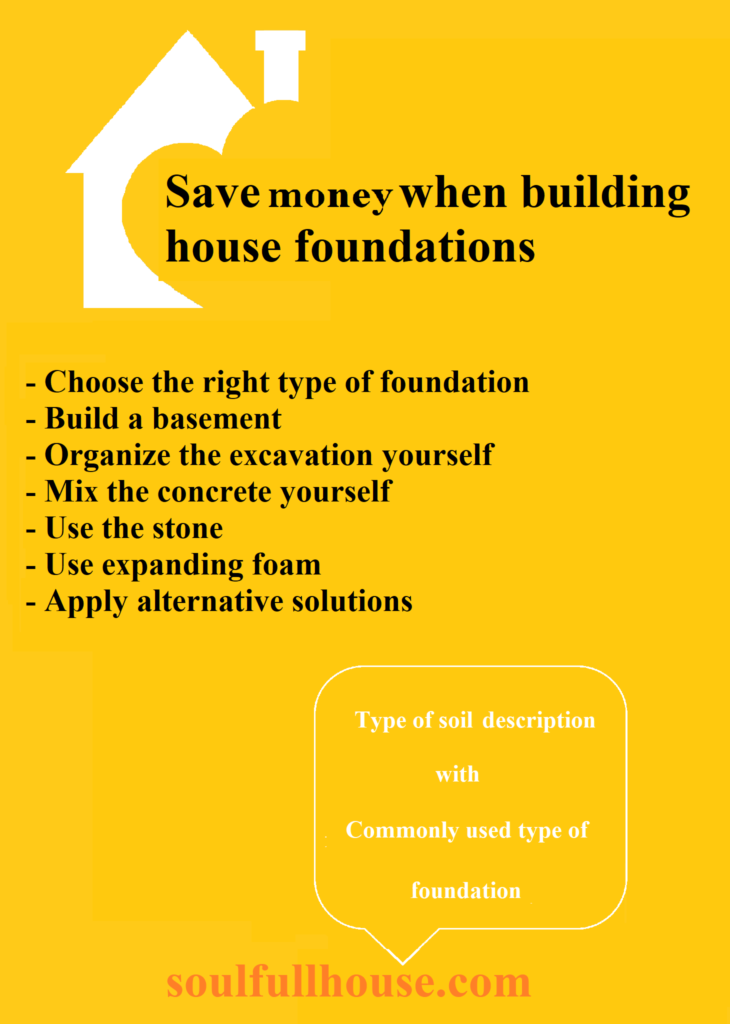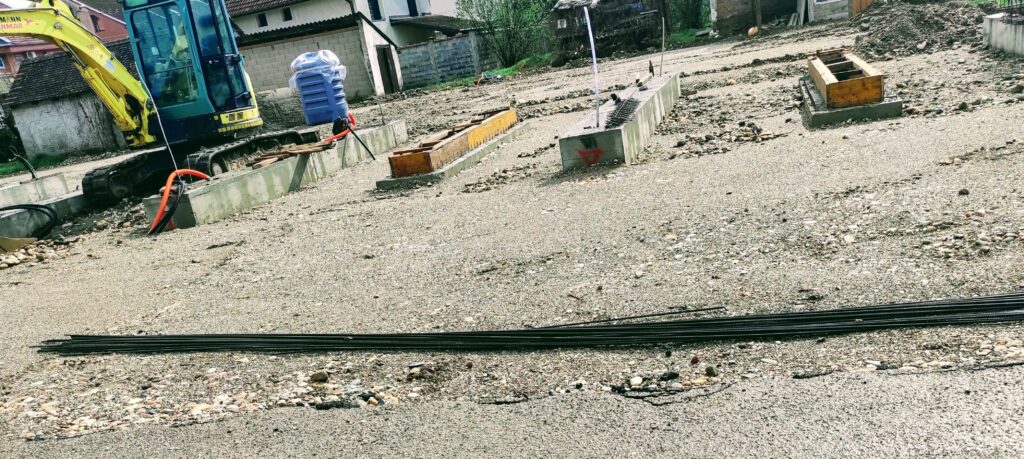This article does not deal with DIY, but brings a list of suggestions and ideas on how to save money by investing your own time and a different way of thinking, while respecting the principles from the above.

There are three basic principles on how to save money when building a house foundation. We can save money by purchasing cheaper materials, providing cheaper labor and increasing the effective square footage of the house within the same foundation. What must not be done in any way is a compromise with quality!
7 Ways to Save Money When Building a Foundation
1. Choose the right type of foundation
There are two basic constructional types of foundations: Concrete Slab and Crawlspace. There are also a few variants among them. The choice of the type of foundation in a particular case depends on factors related to ground (soil) conditions and factors related to structural loads.
Structural loads depend on the type of construction of the house you want to build (prefabricated house, brick house, modern one built of concrete walls…).

On the other hand, your plot has a specific soil bearing capacity (depending on the type of soil), slope (or it is flat), climatic conditions (soil freezing, flooding), which are all factors that determine the choice of type of foundation. Another factor that must not be forgotten is the probability of natural disasters in the area (earthquakes above all).
When all the factors are taken into account, you should choose the foundation that is most optimal for you and save money because you will not have expensive repair costs due to future damage and you will not give money in the beginning for a foundation that is unnecessarily strong and therefore expensive.
| Type of soil | Description | Commonly used type of foundation |
| Clay Soil | great capacity for water retention, foundation structure can suffer from great settlement and uplift pressure, minimum depth of 1m and 3m if there are trees around, | Raft/Mat foundation |
| Peat Soil | considerably porous, easily compressible, commonly present near wetlands, the best option, if feasible, is to remove the peat, and if this is not possible, it is necessary to reach a solid ground with a foundation structure or replace part of the peat with clean sand and use geotextile to make a barrier | reinforced raft foundation |
| Silt | generally not suitable for foundation structure because of its expansion which exert pressure against foundation and damage it | Pier and beam foundations |
| Sand and Gravel | Sand and gravel allow water drainage that is why do not cause structural movement. Moist compaction of soil and sand make good support for foundation structure. | spread and strip foundations |
| Rock | substantially high bearing capacities | Insulated concrete forms |
| Loam | Loam is a combination of clay, silt, and sand, and the best option to support foundation because of its uniformly balanced characteristics. | Many options |
| Previously Used Soil | Soil on a site previously used for buildings or other structures. | Raft foundation |
| Mountain and Forest Soils | most likely to have boulders at various depths | Isolated reinforced pad or reinforced concrete strip foundations |
2. Build a basement
One way to save when building a foundation is to build a basement. Of course, a foundation with a basement is more expensive to build than a foundation without it, but in this way the effective area of the house is increased and thus the cost of building a house per square foot is reduced.
A basement can be built on any type of foundation, but many people do not like basements and consider them not usable enough. The main reason for this is that the basements in most old houses are full of moisture, unventilated and dark. Modern hydro insulation techniques and the construction of so-called daylight or walkout basements make it possible to overcome these problems. Thanks to the natural light its windows and doors provide, they lack the “basement feel” people aren’t fans of, so a gaming area, family room, guest space or anything else your imagination can come up, can easily be built, especially on a sloped lot!
From my experience, there is only one situation in which I would strongly advise against constructing a basement. This occurs when development is undertaken on land with a shallow aquifer. Although modern building techniques and procedures make this kind of construction possible, I believe the actual benefits do not match the additional costs and potential risks.
3. Organize the excavation yourself
The easiest and simplest way to dig up space for a foundation is to pay the contractor. At the same time it is the most expensive way. If you want to save money, and you are not afraid to bother a little bit, dig it yourself! You have two options.
We have already written about DIY-friendly works during and DIY-friendly works after construction that we recommend.
The first is to rent an excavator. This is a good option if you have a large amount of excavation (say a foundation with a large basement and a pool next to it). You can even consider the option of buying a used excavator. After you get the job done, sell it. The money you initially invested will easily be recouped and there is always a market demand for these machines.
If, on the other hand, you do not have a large amount of excavation or you are not skilled in operating the machine, then gather as many friends, neighbors, colleagues and relatives ready to help you and dig the foundation by hand. Organize a barbecue, bring a lot of beer, provide music and with minimal costs the job will be done. You will also have a good time. Of course, when you have the opportunity, you will return the favor.

4. Mix the concrete yourself
If you want to save money do not buy ready-mixed concrete, you have the option to mix your own, just buy cement and gravel. You will have to rent a small concrete mixer for a fixed fee per day of use, or, to buy it because it really isn’t expensive and can often be needed in the future.
Concrete in the foundation should be poured at once; otherwise it will produce a “cold seam” that weakens the structure. So, apply the same strategy as for digging the foundations, gather a large and quality team, roll up your sleeves, get the job done, have a party and not only will you save money but you will be proud of the fruits of your labor all your life.
5. Use the stone
If you are ready for hard work for maximum money savings, the right option for your foundation is stone. This is a particularly interesting option for those who can get to the building stone on their own property. Stone foundations have been used, successfully, for thousands of years around the world, they are solid, they absorb water brilliantly preventing the appearance of moisture, stone has one of the highest compressive strengths of all building materials (you would have to stack up stone blocks 4 kilometers high before the block on the bottom got crushed!!!) and of all masonry products (brick, concrete, block, man-made products, etc.) natural stone is by far the most durable.
As we all know, stone foundations are very rarely built today, and there is a reason why. Firstly, if you have to buy the stone, the price increases drastically and the question of economy arises, secondly, the construction of such a foundation is many times longer, so the question of efficiency arises, and last but not least, you can’t start building such a foundation if you don’t have at least one expert to lead the works.
6. Use expanding foam
If you need to build on an old foundation that has certain cracks, or build a fence, a shed, a mailbox or a sign post, look no further, this is the right material for you. Cheap enough and easy to operate to turn any problem into a daily DIY project. Just keep in mind that it cannot be used where there are higher structural loads.
7. Apply alternative solutions
Modern architecture abounds in innovative technologies in all areas of application, including when it comes to building foundations. On the internet you can find dozens of lucid ideas on how to build a foundation faster, easier and cheaper (this especially refers to the cases where the construction site or investor requirements are atypical). Do your own research and we will mention the ones that caught our eye:
Conclusion. The cost of building a foundation is a significant part of the overall cost of building a house. Therefore, it is essential to find ways to save money without compromising the quality of the foundation. This blog post suggests seven ways to save money when building a foundation. The first is to choose the right type of foundation based on factors such as soil conditions, structural loads, and climatic conditions. Building a basement is another way to save money by increasing the effective square footage of the house within the same foundation. Organizing excavation and mixing concrete yourself are also ways to save money. Using stone as a building material, optimizing the dimensions of the foundation, and providing labor can also help reduce costs. However, one must never compromise on the quality of the foundation.
